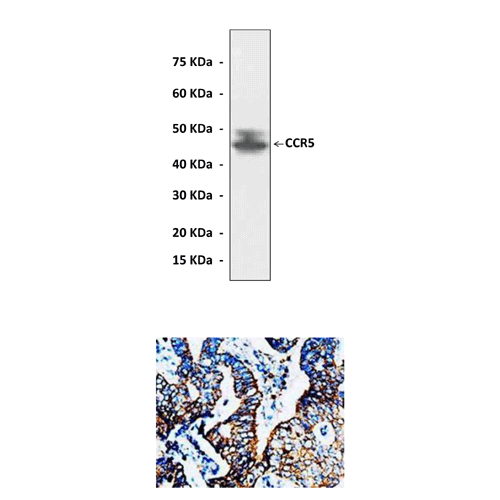Anti-CCR5: Polyclonal C-C Chemokine receptor 5 Antibody
Polyclonal C-C Chemokine Receptor 5 Rabbit Antibody: Polyclonal C-C Chemokine Receptor 5 Rabbit Antibody
Size: 100 ul
Price: $375.00
Description
CCR5 is a member of the beta chemokine receptor family, which is predicted to be a seven transmembrane protein similar to G protein-coupled receptors. This protein is expressed by T cells and macrophages, and is known to be an important co-receptor for macrophage-tropic virus, including HIV, to enter host cells. Defective alleles of this gene have been associated with the HIV infection resistance.3 The ligands of this receptor include a number of inflammatory CC-chemokines including MIP-1-alpha, MIP-1-beta and RANTES and it subsequently transduces a signal by increasing the intracellular calcium ion level. Expression of this gene was also detected in a promyeloblastic cell line, suggesting that this protein may play a role in granulocyte lineage proliferation and differentiation.4 This gene is located at the chemokine receptor gene cluster region. Two transcript variants encoding the same protein have been found for this gene.
2. Locati, M.: Ann. Rev. Med. 50:425-40, 1999
3. Moore, J.P. et al: AIDS Res Hum. Retrovir. 20:111-126, 2004
4. Turner, J.E. et al: Mini Rev. Med. Chem. &;1089-96, 2007
Details
| Cat.No.: | CA0707 |
| Antigen: | N-terminal sequence of human CCR5 |
| Isotype: | Affinity-Purified Rabbit Polyclonal IgG |
| Species & predicted species cross- reactivity ( ): | Human, Rabbit, Rat, Mouse |
| Applications & Suggested starting dilutions: | WB 1:500 to 1:1000 IP n/d IHC (Paraffin) 1:50 to 1:200 ICC n/d FACS n/d |
| Predicted Molecular Weight of protein: | 40 – 60 kDa |
| Specificity/Sensitivity: | Anti-CCR5 reacts specifically with CCR5 of human, mouse & rat origin in immunostaining and western blotting, no cross-reactivity with other members of the family. |
| Storage: | Store at 4° C for frequent use; at -20° C for at least one year. |
*Optimal working dilutions must be determined by end user.
